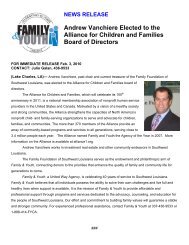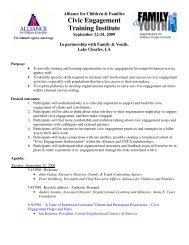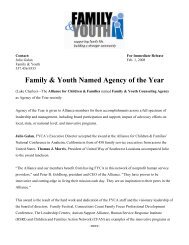Mission-based Advocacy Toolkit from Alliance for Children & Families
Mission-based Advocacy Toolkit from Alliance for Children & Families
Mission-based Advocacy Toolkit from Alliance for Children & Families
Create successful ePaper yourself
Turn your PDF publications into a flip-book with our unique Google optimized e-Paper software.
Part III: Helpful <strong>Advocacy</strong> Techniques and Framework<br />
Bite-sized <strong>Advocacy</strong> <strong>for</strong> Busy Lives<br />
Step 1. Sign up <strong>for</strong> good “Alerts.” Get on a list <strong>for</strong> regular in<strong>for</strong>mation about<br />
legislative actions likely to affect your issue/program. (E.g., a statewide child<br />
advocacy organization, a state nonprofit association, and/or a national group<br />
you trust). They will monitor the legislative process, keep you in<strong>for</strong>med,<br />
provide a sample “message,” and help you know when your voice is needed<br />
most. Best of all: they’re free!<br />
Step 2. Use the TELEPHONE or WRITE<br />
Send a message to your state legislators.<br />
Some states have a TOLL-FREE hotline to their State Capitol, others have a<br />
regular number. Operators will take your call, or take your message, or transfer<br />
you to your legislator's office. Whatever the method, it only takes about two<br />
minutes because you can use the message provided in the "alert" you signed up<br />
<strong>for</strong> in Step # 1.<br />
Or you can use that alert to send a simple email message. Mention the bill<br />
number or issue in the subject line, state what you want the legislator to do,<br />
and be sure to put your home address so they know that you live in their<br />
Legislative District. Keep it short and to the point. (At times when you cannot<br />
lobby, just provide in<strong>for</strong>mation about the issue – leaving off the request <strong>for</strong> a<br />
particular action.)<br />
Finding telephone numbers and/or email addresses is easy: just go to the<br />
website <strong>for</strong> your state Capitol, and follow directions <strong>for</strong> finding your<br />
legislators, or contact the League of Women Voters.<br />
Sending a message to the U.S. Congress<br />
It’s easy to send a prepared message to your U.S. Senators and Representative:<br />
just use a service called CAPWIZ. You can personalize the message, or simply<br />
add your name and address and let CAPWIZ send the message automatically<br />
to your representatives in Congress. The <strong>Alliance</strong> frequently posts messages on<br />
CAPWIZ. You can view these by logging on to the <strong>Alliance</strong>’s Web site,<br />
www.alliance1.org, and selecting the public policy page <strong>for</strong> a link to all<br />
CAPWIZ messages.<br />
Step 3. Help others<br />
Make cardstock “cell phones” with the Capitol website, telephone number, and<br />
the dates when the Legislature is in Session. Add your own logo, website, or<br />
agency name. Make up a supply, and give them to everyone you encounter:<br />
board members, staff, consumers, friends, neighbors, and extended family. You<br />
and they should pledge to make one toll-free call or email every week the<br />
legislature is in Session.<br />
26<br />
© January 2006 The <strong>Alliance</strong> <strong>for</strong> <strong>Children</strong> and <strong>Families</strong>










